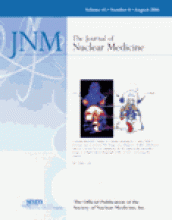
The year since I assumed editorial responsibility for The Journal of Nuclear Medicine (JNM), and the 6 months since I became its editor-in-chief, have brought rewards and challenges. The manuscript submission and review process has now been completely converted from paper based to Internet based. This has allowed for faster communication between authors, reviewers, and the editorial office and has contributed to substantial shortening of the manuscript review process. The time from submission to first decision currently averages about 1 month. Much of the credit for accelerating the review process also goes to the many referees and their thoughtful and rapid manuscript evaluations. The shortening of the review process has also led to a substantial increase in the number of manuscripts submitted to JNM. Online posting of accepted and fully processed manuscripts, soon to be implemented, will reduce further the time from submission to publication of manuscripts.
The diversity and scope of manuscripts received by JNM are truly impressive, for they reflect the enormous breadth of our field. They range from the very basic sciences to investigations that directly affect diagnosis and patient care. The diversity of topics also reflects geographic differences in emphasis and development. At the same time, the very diversity and scope of manuscripts pose considerable challenges for balancing the content of JNM, especially between topics in the clinical and basic sciences, and for best meeting the needs of the readership.
Understandably, the content of JNM largely depends on the mix and scientific quality of contributions. However, several main themes emerge. A first theme comprises PET and, especially, PET/CT for merging function with structure. Investigations in this area refine the diagnostic process and enhance the integration of PET into patient care. A second theme comprises development of molecular radiotherapy approaches and demonstration of their therapeutic efficacy. A third theme comprises molecular imaging, with its use of nuclear medicine–specific methodologies for delineating disease mechanisms and for guiding gene-, molecule-, and cell-based therapies. One can easily envision the merger of these research themes into a powerful and patient-specific approach to diagnosis and treatment with potentially profound effects on the future practice of nuclear medicine.
Major developments, challenges of established views, and innovations deserve emphasis and thoughtful analysis. JNM provides the means to this end. One means is the publication of “Invited Perspectives,” in which leading experts examine the significance and implications of new contributions and how they might influence our field. Another means is the publication of supplements intended to highlight specific areas of development in nuclear medicine and to serve as an educational resource. The first supplement, PET/CT: Imaging Function and Structure, was published earlier this year; a second one, in progress, focuses on molecular radiotherapy and its clinical application. The educational content of each supplement is linked to test questions that are posted on the Web site of the Society of Nuclear Medicine and offer credit hours toward continuing medical education.
JNM also serves as a forum for scientific exchange and discussion. Obviously, publication and dissemination of original research are key ingredients but need complementation and enhancement through communication of contrasting views and opinions as expressed in letters to the editor, which I encourage and welcome. Of similar intent are monthly editorials, initiated by this one, that address issues of general interest to the nuclear medicine community.
The growing recognition of JNM has been especially rewarding. The science edition of the Thomson ISI Journal Citation Reports for 2003 lists an impact factor of 4.899 for JNM, so that it now ranks third among 83 journals on radiology, nuclear medicine, or medical imaging. This achievement under the stewardship of my predecessor, Dr. Martin Sandler, represents the challenge of, but even more so an incentive for, guiding the journal through the coming years.







